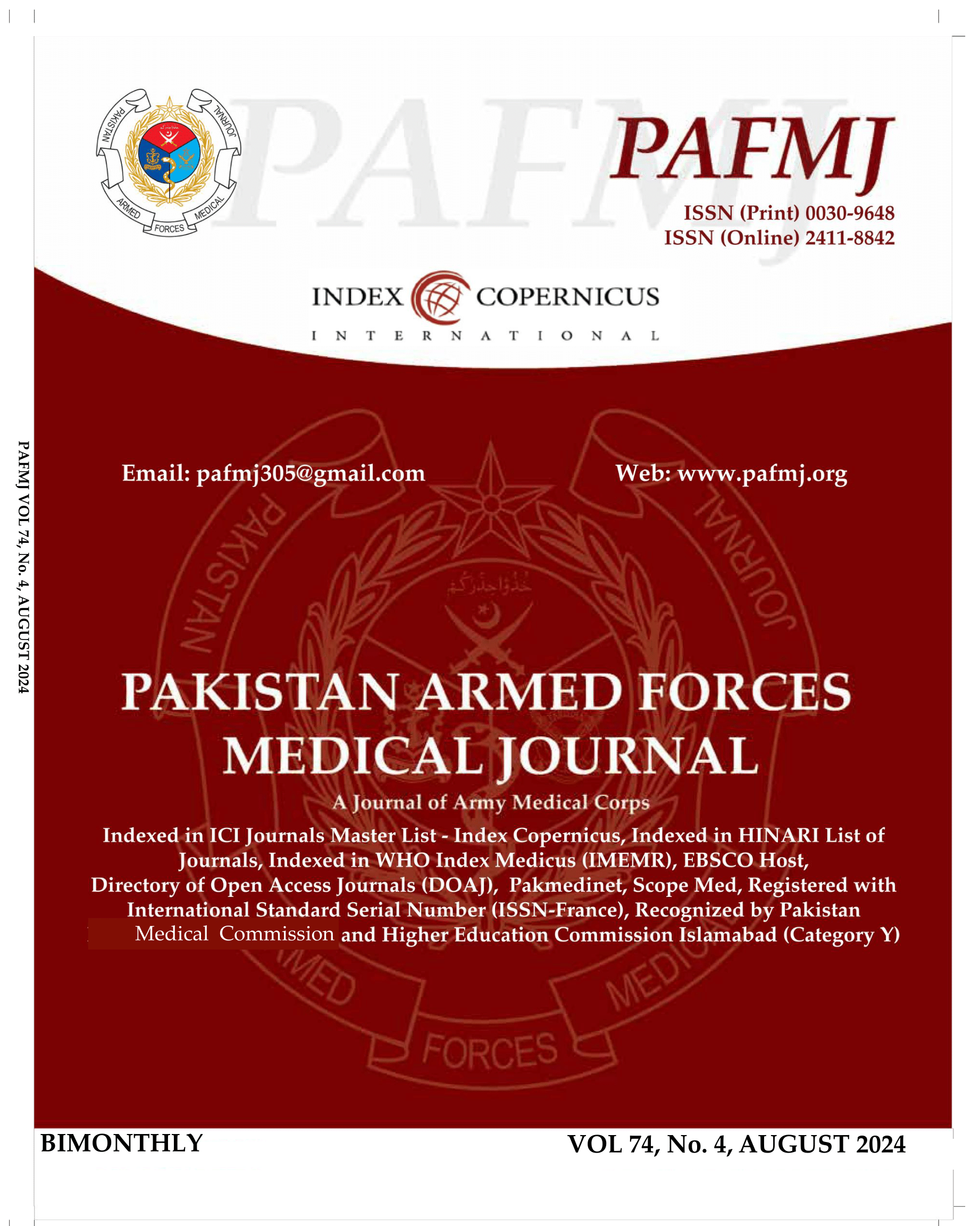Tibialis Posterior Transfer for Foot Drop: Difference in Outcome for Two Different Attachment Sites
DOI:
https://doi.org/10.51253/pafmj.v74i4.7275Keywords:
Attachment site, foot drop, tibialis posterior transfer.Abstract
Objective: To compare the outcome of Posterior Tibialis tendon transfer to two different attachment sites in terms of post-surgery dorsiflexion strength.
Study Design: Quasi-experimental study.
Place and Duration of Study: Department of Plastic Surgery, Combined Military Hospital, Rawalpindi Pakistan, Jul 2020 to Jul 2021.
Methodology: We studied a total of 30 patients who developed Common Peroneal Nerve palsy. Patients with previous surgery, especially those with posterior tibiali tendon transfer were excluded. Patients were divided into two equal groups of 15 patients each, with Group-A receiving surgery with the modified Barr’s technique while Group-B received classic Barr’s technique. All participants were followed up at six months for degree of ankle dorsiflexion, varus deformity and hypercorrection.
Results: None of the cases which underwent modified Barr’s technique developed varus deformity, as opposed to 4(26.7%) cases with the classic technique (p=0.032). For hypercorrection, no cases were seen with the modified technique versus 5(33.3%) cases with the classic technique (p=0.014). All cases with the modified technique developed some improvement in active dorsiflexion with 14(93.3%) achieving normal range, while 12(80%) showed some improvement with the classic technique and only 7(46.7%) acquired normal range (p=0.018).
Conclusion: The modified Barr’s technique was superior to the classic Barr’s technique for posterior tibialis transfer in cases of foot drop in terms of functional outcomes.
Downloads
References
Hardin JM, Devendra S. Anatomy, Bony Pelvis and Lower Limb, Calf Common Peroneal (Fibular) Nerve. StatPearls. Treasure Island (FL): StatPearls Publishing; 2020.
Poage C, Roth C, Scott B. Peroneal nerve palsy: evaluation and management. J Am Acad Orthop Surg 2016; 24(1): 1-10.
https://doi.org/10.5435/JAAOS-D-14-00420
Thatte H, De Jesus O. Electrodiagnostic evaluation of peroneal neuropathy. StatPearls. Treasure Island (FL): StatPearls Publishing; 2021.
Samson D, Ng CY, Power D. An evidence-based algorithm for the management of common peroneal nerve injury associated with traumatic knee dislocation. EFORT Open Rev 2017; 1(10): 362-367. https://doi.org/10.1302/2058-5241.160012
Moatshe G, Dornan GJ, Løken S, Ludvigsen TC, LaPrade RF, Engebretsen L. Demographics and injuries associated with knee dislocation: a prospective review of 303 patients. Orthop J Sports Med 2017; 5(5): 2325967117706521.
https://doi.org/10.1177/2325967117706521
Fuhrmann RA, Wagner A. Dorsal release of the ankle with transfer of the posterior tibial tendon in patients with paralytic drop foot. Oper Orthop Traumatol 2009; 21(6): 533-544.
https://doi.org/10.1007/s00064-009-2003-1
Lezak B, Massel DH, Varacallo M. Peroneal nerve injury. StatPearls. Treasure Island (FL): StatPearls Publishing; 2021.
Baima J, Krivickas L. Evaluation and treatment of peroneal neuropathy. Curr Rev Musculoskelet Med 2008; 1(2): 147-153.
https://doi.org/10.1007/s12178-008-9023-6
Ho B, Khan Z, Switaj PJ, Ochenjele G, Fuchs D, Dahl W, et al. Treatment of peroneal nerve injuries with simultaneous tendon transfer and nerve exploration. J Orthop Surg Res 2014; 9: 67.
https://doi.org/10.1186/s13018-014-0067-6
Krishnamurthy S, Ibrahim M. Tendon transfers in foot drop. Indian J Plast Surg 2019; 52(1): 100-108.
https://doi.org/10.1055/s-0039-1688105
Salihagić S, Hadziahmetović Z, Fazlić A. Classic and modified Barr's technique of anterior transfer of the tibialis posterior tendon in irreparable peroneal palsies. Bosn J Basic Med Sci 2008; 8(2): 156-159.
https://doi.org/10.17305/bjbms.2008.2973
Girolami M, Galletti S, Montanari G, Mignani G, Schuh R, Ellis S, et al. Common peroneal nerve palsy due to hematoma at the fibular neck. J Knee Surg 2013; 26(Suppl 1): S132-135.
https://doi.org/10.1055/s-0032-1330055
Emamhadi M, Bakhshayesh B, Andalib S. Surgical outcome of foot drop caused by common peroneal nerve injuries; is the glass half full or half empty? Acta Neurochir 2016; 158(6): 1133-1138. https://doi.org/10.1007/s00701-016-2808-2
Yeganeh A, Motaghi A, Shahhoseini G, Farahini H. New method for fixation point of tibialis posterior tendon transfer. Med J Islam Repub Iran 2013; 27(4): 163-167.
Barrios C, Bernardo ND, Vera P, Laíz C, Hadala M. Changes in sports injuries incidence over time in world-class road cyclists. Int J Sports Med 2015; 36(3): 241-248.
https://doi.org/10.1055/s-0034-1389983
Breukink SO, Spronk CA, Dijkstra PU, Heybroek E, Marck KW. Transposition of the tendon of M. tibialis posterior an effective treatment of drop foot; retrospective study with follow-up in 12 patients. Ned Tijdschr Geneeskd 2000; 144(13): 604-608.
Nori SL, Stretanski MF. Foot drop. StatPearls. Treasure Island (FL): StatPearls Publishing; 2021.
Wiszomirska I, Błażkiewicz M, Kaczmarczyk K, Brzuszkiewicz-Kuźmicka G, Wit A. Effect of drop foot on spatiotemporal, kinematic, and kinetic parameters during gait. Appl Bionics Biomech 2017; 2017: 3595461.
https://doi.org/10.1155/2017/3595461
Dreher T, Wolf SI, Heitzmann D, Fremd C, Klotz MC, Wenz W. Tibialis posterior tendon transfer corrects the foot drop component of cavovarus foot deformity in Charcot-Marie-Tooth disease. J Bone Joint Surg Am 2014; 96(6): 456-462.
https://doi.org/10.2106/JBJS.L.01749
Clanton TO, Betech AA, Bott AM, Matheny LM, Hartline B, Hanson TW, et al. Complications after tendon transfers in the foot and ankle using bioabsorbable screws. Foot Ankle Int 2013; 34(4): 486-490. https://doi.org/10.1177/1071100713477625
Molund M, Engebretsen L, Hvaal K, Hellesnes J, Ellingsen Husebye E. Posterior tibial tendon transfer improves function for foot drop after knee dislocation. Clin Orthop Relat Res 2014; 472(9): 2637-2643. https://doi.org/10.1007/s11999-014-3533-x
Downloads
Published
Issue
Section
License
Copyright (c) 2024 Shah Faisal, Shahid Hameed, Abdul Majid, Farman Mahmood, Tabish Samuel, Afia Ayub

This work is licensed under a Creative Commons Attribution-NonCommercial 4.0 International License.















